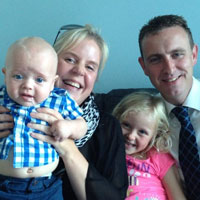Personal Stories

Clare Reynolds
Liverpool, United Kingdom
For the past 10 years, Clare Reynolds has suffered repeated clotting episodes.
The first in 2004 was a massive ileo femoral deep vein thrombosis (DVT) and since then she has had about eight other clots, including one clot in the arm and two DVTs that progressed to pulmonary emboli (PE).
Clare has severe post thrombotic syndrome (PTS), which caused her to give up work, and change her life completely. To relieve the PTS, she has had two ileo femoral bypass operations, both of which have failed.
This may sound like a sad tale, but thrombosis (with its constant injections and hospital visits) in its own funny way has made Clare the happiest she has ever been. Thrombosis, according to Clare, gave her the opportunity to meet her fiancée since she had the time (and the courage!) while recovering to enroll in an online dating service. Clare and her partner now have two beautiful children, all because of this change of course. While clots have prevented her from out-of-the-home employment, she is a full-time mum and a volunteer with Lifeblood.
Who knows what the future will bring. Clare will always be a "clotter," but now lives her life knowing her limitations. "I control my disorder, it doesn't control me!"



